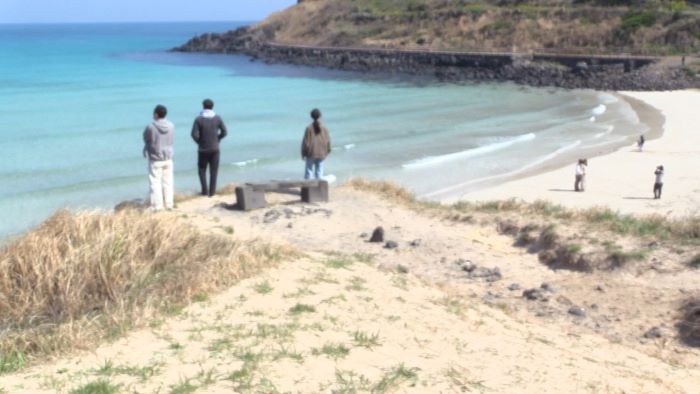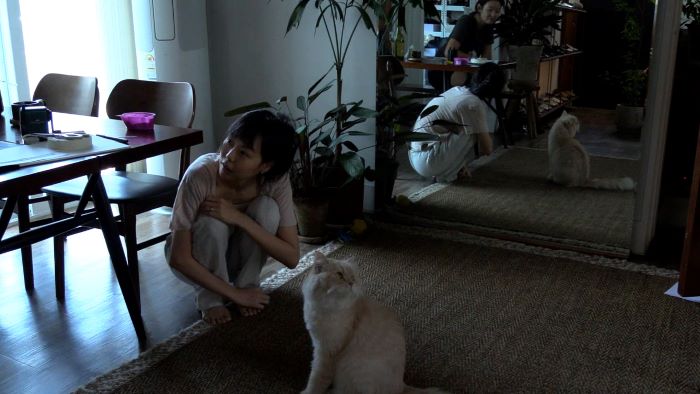Over the course of a nearly three-decade filmmaking career, the Korean auteur Hong Sang-soo has meticulously carved out a unique corner of the world cinema landscape. His narratives usually consist of portraits of artists—film directors, actors, novelists, and poets—navigating the relationships between their personal lives and their art. Conversation, romantic conflicts, and alcohol (most pertinently, the Korean rice liquor known as soju) are crucial ingredients. In recent years, Hong has been an incredibly prolific fixture at film festivals, regularly producing at least two features per year. Consequently, it’s been an almost routine occurrence to see two of his films included in the New York Film Festival, and this year is no exception, with In Water and In Our Day, his 29th and 30th features respectively, appearing in the festival’s Main Slate.
Of the two, In Water is the more boldly challenging and experimental. This slender feature clocks in at barely more than an hour and is marked most immediately by its visual choice, images that are, in various degrees, out of focus. Formally, this puts the movie at the intersection of cinema and impressionist painting. Thematically, it mirrors the conceptual haziness plaguing Seoung-mo (Shin Seok-ho), a young actor attempting to make a short film without a shooting script. Instead, he searches the natural landscape for inspiration to lead him to his subject matter. This intuitive approach to filmmaking, not incidentally, is remarkably similar to Hong’s own methods: He shoots his films without a script beforehand, improvising his narratives as he goes along with just a basic outline to guide him. Of course, there’s a considerable gulf of experience between Hong, with decades of films under his belt, and a first timer like Seoung-mo.
Seoung-mo has come to Jeju Island, a popular Korean vacation destination, in the off-season to make his film, accompanied by Nam-hee (Kim Seung-yun), an actress, and Sang-guk (Ha Seong-guk), the cameraman. Through conversations, we gather that Seoung-mo is dissatisfied with his current profession of acting, and has become a filmmaker to find more substantial and lasting artistic fulfillment. Though he’s presumably far from wealthy, he’s spending a considerable amount of his own money renting beachside living quarters and feeding his small crew to realize his project.
The film’s images don’t become clearer—this blurriness may be a reference to Hong’s own reported eyesight problems in recent years—as Seoung-mo and his collaborators scout locations and Seoung-mo gains inspiration from a conversation with a woman about her practice of clearing debris from beaches. Gradually, he realizes what he wants to say with his project. Although exactly what is never clearly imparted, it’s hinted at in the haunting final image: the wavy, shimmering sight of Seoung-mo disappearing into the sea as a mournful solo guitar and a woman’s singing voice on the soundtrack accompany him.
In contrast to In Water’s unusual visuals, In Our Day offers more of what regular viewers of Hong’s films have come to expect: conversations about life and art among a limited set of characters (usually over liquor and food) in equally limited locations, as well as an elegantly spare narrative.
Seemingly taking place over the course of a single day, In Our Day alternates scenes revolving around two central characters. An actress who’s quit her profession and is at loss about what to do with her life, Sang-won (Kim Min-hee, Hong’s partner and frequent actress/collaborator) is currently staying with her friend Jung-soo (Hong regular Song Sun-mi), who has recently returned to Korea after a period living abroad. In their opening conversation, they affirm their bond over Jung-soo’s cute and plump pet cat named Us, which they take turns feeding, and delight in the cat’s obvious pleasure in being fed, despite Jung-soo’s concerns about the cat’s weight. The sudden absence of Us later on occasions the most conventionally dramatic scenes, with Jung-soo being inconsolably distraught over the loss of the cat.
Uiji (Ki Joo-bong, another Hong regular) is an aging poet who has recently gained a following among young people, according to an introductory title card. Presumably, this is why he’s now being shadowed by Ki-joo (Kim Seung-yun), a young woman film student making a documentary about him. Uiji laments the fact that, because of doctors’ orders, he can no longer smoke or drink alcohol, two activities he used to enjoy immensely. Although Sang-won and Uiji’s narrative paths remain separate, parallels between them abound: They’re both asked for advice about life and art from younger acolytes, and they both enjoy eating ramen noodles spiced generously with hot pepper paste.
In Our Day and In Water may be radically different visually, but what they both abundantly represent is Hong’s remarkable ability to find seemingly endless variations on similar milieus, characters, and themes. Now that Hong takes on most of the creative and technical aspects of his films—writing, cinematography, editing, music—all on his own, this is as close to a pure expression of a filmmaker’s artistry and intent as you’re likely to see. While there’s likely more to be enjoyed here by die-hard Hong fans than to those coming to his work for the first time, these two features represent worthy additions to the oeuvre of one of cinema’s more meticulously talented and fascinating artists.








Leave A Comment